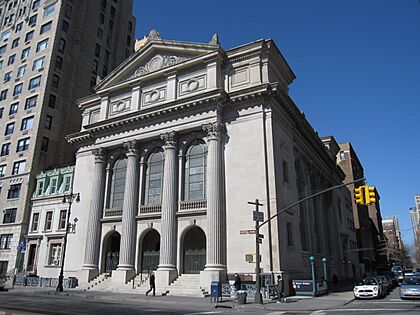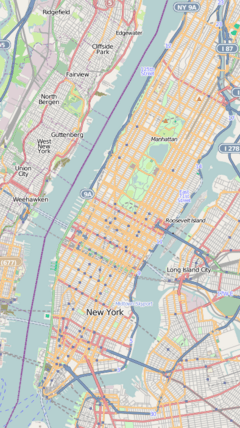Congregation Shearith Israel facts for kids
Quick facts for kids Congregation Shearith Israel |
|
|---|---|
|
Hebrew: קהילת שארית ישראל
|
|

Congregation Shearith Israel at Central Park West
|
|
| Religion | |
| Affiliation | Orthodox Judaism |
| Rite | Spanish and Portuguese (Western Sephardic) |
| Ecclesiastical or organizational status | Synagogue |
| Leadership |
|
| Status | Active |
| Location | |
| Location | 2 West 70th Street, Upper West Side, Manhattan, New York City, New York |
| Country | United States |
| Architecture | |
| Architect(s) | Arnold Brunner |
| Architectural type | Synagogue |
| Architectural style | Neoclassical |
| Date established | 1654 (as a congregation) |
| Completed | 1897 |
| Direction of façade | East |
The Congregation Shearith Israel (Hebrew: קהילת שארית ישראל, romanized: Kehilat She'arit Yisra'el, lit. 'Congregation Remnant of Israel'), often called The Spanish and Portuguese Synagogue, is an Orthodox Jewish synagogue in New York City. It is located at 2 West 70th Street, near Central Park West, on the Upper West Side of Manhattan.
This congregation was started in 1654 in New Amsterdam (which is now New York City). It was founded by Jewish people who came from Dutch Brazil. This makes it the oldest Jewish congregation in the United States. Until 1825, it was the only Jewish congregation in New York City.
The synagogue follows the Sephardic rite, which is a specific way of Jewish prayer and tradition. Its current building, built in 1897, has a Neoclassical style, which means it looks like ancient Greek and Roman buildings.
Contents
History of the Synagogue Buildings
Early Beginnings in New Amsterdam
The first group of Spanish and Portuguese Jews arrived in New Amsterdam in September 1654. There were twenty-three refugees from Dutch Brazil. At first, the leader of New Netherland, Peter Stuyvesant, did not want them to stay.
However, in 1655, Jewish people were officially allowed to settle in the colony. This year is considered the founding year of Congregation Shearith Israel. Even though they could stay, they faced challenges and were not allowed to build a public synagogue for a long time.
The congregation did arrange for a cemetery starting in 1656. This was an important step for the community.
Building Their Own Synagogue
It took until 1730 for the congregation to build its very own synagogue. This first building was on Mill Street (now South William Street) in lower Manhattan. People said the Mill Street synagogue had access to a nearby spring. This spring was used as a mikveh, which is a special bath for religious cleansing.
Before 1730, the congregation worshipped in rented places. A map from 1695 shows they met on Beaver Street and later on Mill Street.
Since 1730, Congregation Shearith Israel has used five different synagogue buildings:
- Mill Street, built in 1730
- Mill Street, rebuilt and made bigger in 1818
- 60 Crosby Street, built in 1834
- 19th Street, built in 1860
- West 70th Street, built in 1897 (this is the building they use today)
The current building on West 70th Street was updated and improved in 1921.
Helping Start Important Jewish Groups
The Jewish Theological Seminary
In the late 1800s, a new movement called American Reform Judaism became popular. Many rabbis who followed traditional Judaism wanted to make their synagogues stronger. Congregation Shearith Israel and its rabbi, Henry Pereira Mendes, were leaders in these efforts.
Rabbi Mendes helped start the American Jewish Theological Seminary (JTS) in 1886. The goal was to train traditional rabbis. The first classes for JTS were held right at Shearith Israel. In its early days, JTS taught Jewish law and traditions in a way similar to older Jewish schools. This was different from the Reform Hebrew Union College.
The Orthodox Union
Twelve years later, in 1896, Rabbi Mendes was the acting president of JTS. He helped create the Union of Orthodox Jewish Congregations of America. This group is often called the OU or the Orthodox Union. It became a large organization for Orthodox synagogues. The OU offered a different choice from the Reform Union of American Hebrew Congregations.
Changes and Alignments
As JTS grew, it needed more money and a full-time leader. The seminary moved to its own building, and Solomon Schechter took over from Mendes. However, Schechter developed a less traditional approach to Judaism. This approach became the basis for Conservative Judaism.
At first, Orthodox and Conservative groups worked together a lot. But over time, their differences became clearer. Schechter also formed the United Synagogue of America (now the United Synagogue of Conservative Judaism, or USCJ). This group was created to connect synagogues that followed his Conservative ideas.
Congregation Shearith Israel stayed true to the Orthodox tradition. It eventually ended its official connection with JTS. In a way, Shearith Israel helped create three of the biggest and most important Jewish religious organizations in the United States: JTS, the OU, and USCJ. Today, Shearith Israel is only a member of the Orthodox Union.
Synagogue Leaders
Rabbis of Shearith Israel
A rabbi is a Jewish religious leader and teacher. Here are some of the people who have served as rabbi for Congregation Shearith Israel:
| Order | Name | Start year | End year | Notes |
|---|---|---|---|---|
| 1 | Benjamin Wolf | |||
| 2 | Gershom Mendes Seixas | He was a Hazzan (cantor) and a strong American patriot. He moved the congregation to Philadelphia when the British took over New York during the American Revolutionary War. | ||
| 3 | Moses L. M. Peixotto | |||
| 4 | Isaac B. Seixas | 1828 | 1839 | |
| 5 | Jacques Judah Lyons | 1839 | 1877 | |
| 6 | Henry S. Jacobs | 1874 | 1876 | |
| 7 | Henry Pereira Mendes | 1877 | 1920 | |
| 8 | David de Sola Pool | 1907 | 1919 | He was first hired as an assistant rabbi. He left in 1919. After Rabbi Mendes retired, he returned in 1921. |
| 1921 | 1955 | |||
| 9 | Louis B. Gerstein | 1956 | 1988 | |
| 10 | Marc D. Angel | 1969 | 2007 | |
| 11 | Hayyim Angel | 1995 | 2013 | |
| 12 | Meir Soloveichik | 2013 | present |
Parnasim (Presidents)
A parnas is a leader or president of a synagogue. Some notable parnasim of Shearith Israel include Luis Moises Gomez, Israel Baer Kursheedt, and Alvin Deutsch (who served from 1997 to 2001).
Hazanim (Cantors)
A hazzan is a cantor, who leads the musical parts of the prayer service. Important hazanim include Gershom Mendes Seixas (who served from 1768–1776 and again from 1784–1816), Isaac Touro (1780), Jacques Judah Lyons (1839–1877), DanAbraham Lopes Cardozo (1946–1986), Daniel Halfon (1978–1980), and Albert Gabbai (1983–1986).
Famous Members
Many well-known people have been members of Congregation Shearith Israel. Here are a few:
- Jacob Baiz – a merchant and diplomat
- Mark Blumenthal – a doctor and synagogue trustee
- Albert Cardozo – a Justice of the New York Supreme Court
- Benjamin N. Cardozo – a Justice of the Supreme Court of the United States
- Philip J. Joachimsen – a lawyer and judge
- Judith Kaye – the Chief Judge of New York
- Emma Lazarus – a famous poet
- Commodore Uriah P. Levy – the first Jewish Commodore in the United States Navy
- Theodore W. Myers – the New York City Comptroller
- Edgar J. Nathan – a Manhattan Borough President and judge
- Selig Newman – an educator who studied Hebrew
- Mordecai Manuel Noah – an American playwright, diplomat, and journalist
- Isaac Pinto – he created the first Jewish prayer book published in America
- Jack Rudin – a real estate developer
- Arthur Tracy – a singer and actor
Images for kids
-
The synagogue's third cemetery (1829–1851) is on West 21st Street near the Avenue of the Americas
See Also
- First Shearith Israel Graveyard
- Jewish history in Colonial America
- Oldest synagogues in the United States
- Touro Synagogue





